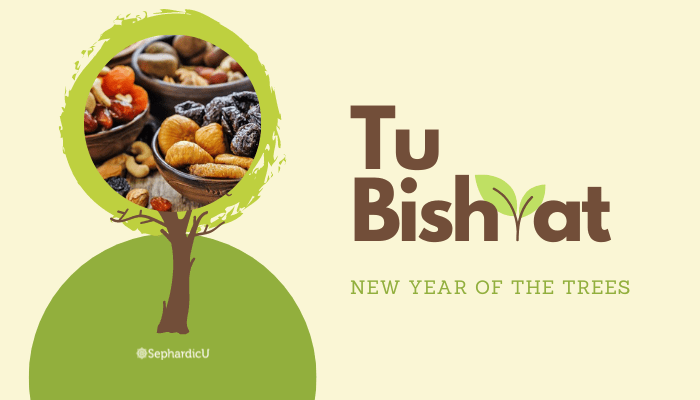The new Year for trees

The Jewish holiday occurs on the 15th day of the Hebrew month of Shevat. It is also called “Rosh HaShanah La’Ilanot” (Hebrew: ראש השנה לאילנות). Literally translated as “New Year of the Trees.” Similar to Arbor Day, in contemporary Israel, the day is celebrated as an ecological awareness day, and trees are planted in celebration.
The first tree to bloom in Israel is the almond tree. It is said that the almond tree will be the first tree that the Messiah will see when he rides his donkey into Jerusalem. Hence, the prominence of almonds and almond-related products on the table for this holiday.
One custom is to eat a new fruit on this day. You can also eat from the Seven Species (shivat haminim) described in the Bible. They symbolize abundancy in the land of Israel. The Shivat Haminim are: wheat, barley, grapes (vines), figs, pomegranates, olives and dates (honey).
The holiday has gained popularity in contemporary Israel as a way to represent the reclamation of desert land for agricultural use. Students perform songs and plant trees during ceremonies.
Many of Israel’s most important institutions have selected this day for its official opening in keeping with the notion that the holiday symbolizes the rebirth of nature. On Tu Bishvat 1918, the Technion in Haifa, on Tu Bishvat 1925, and on Tu Bishvat 1949, the Knesset all laid their respective foundation stones.
In the diaspora, Tu Bishvat grew to be regarded as the Jewish “Earth Day,” with modern groups stressing all manner of actions and advocacy relating to the environment and the natural world, especially in North America in the 1980s.
There are supposed to be thirty (30) types of fruit:
CONTAINS NO PITS
Grapes
Figs
Apples
Etrog (Citron)
Lemon
Pears
Quince
Raspberries
Blueberries
Carob
CONTAINS PITS
Olives
Dates
Cherries
Jujubes
Peaches
Plums
Apricots
Morels
Medlars
Azaroles
CONTAINS PEEL/SHELL
Pomegranates
Walnuts
Almonds
Chestnuts
Hazelnuts
Coconuts
Capers
Pine nuts
Pistachios
Pecans
Visually interact and learn about our nearly 6000 year history.
An interactive tour through our rich heritage spanning from 900 B.C.E.
Learn about our numbers, languages and population.
The greatest minds, philosophers and authors of their time.
Everything you wanted to know about Sephardic customs.
Learn our traditions for brit to marriage and bereavement.
Food is the universal thing that has the power to bring people together.
Listen to the rich repertory of Sephardi music and prayers.
Connect to our calendar for the latest events and happenings.
Read real-time updates as the relates to the Sephardic world.
We welcome you to join us virtually for Shacharit and Arvit.
Make new friends while expanding your mind. Quarterly. Join now.
View the full list of every Jewish holiday and observance.
Browse through our recommended reading list of over 100 books.
Download our guides to help you plan for the Holidays.
We welcome all in need of prayer, healing or Kaddish.

Login to your account
Get notified about new articles
Tu Bishvat
Tu Bishvat, also known as Arbor Day or the Jewish New Year of Trees, is celebrated on the fifteenth of Shevat. It happens on Shevat 15 (January or early February), after the majority of Israel’s annual precipitation has fallen, and when the fruit of a tree is then considered, for tithe purposes, to belong to a new year. The liturgy excludes some penitential prayers, which is regarded as a minor holiday, and fasting is not permitted. Fruits, usually 15 different kinds, are consumed by Ashkenazic Jews together with psalm recitation quite frequently. Among us Sephardic Jews, it is a prominent holiday and a “feast of fruits” accompanied by complex melodies.